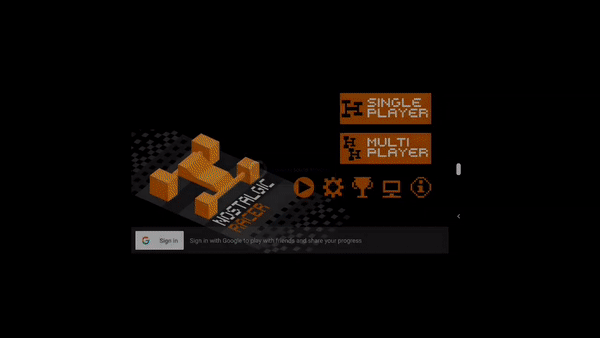如要將遊戲與 Google Play 遊戲服務整合,請先實作平台驗證。您必須完成這項步驟,才能使用所有其他功能,例如成就、排行榜和活動。
如要符合 Google Play 遊戲 Level Up 使用者體驗指南,遊戲必須遵循建議的驗證流程。
初始化和驗證
這是初始化及驗證遊戲的必要步驟:
- 在啟動時初始化 Play 遊戲服務第 2 版 SDK,實作平台驗證。詳情請參閱「Android 遊戲的平台驗證」。如要存取成就和排行榜等 Play 遊戲服務功能,就必須完成這項步驟。
- 遊戲啟動時,驗證會以無聲的背景程序執行。
現有的 Play 遊戲服務使用者成功通過驗證後,會看到歡迎訊息。

建立個人資料
玩家必須擁有 Play 遊戲服務設定檔,才能使用這個平台。部分玩家開始玩遊戲時,可能沒有 Play 遊戲服務設定檔。系統會要求這些玩家建立帳戶。
根據預設,啟動沒有 Play 遊戲服務設定檔的遊戲時,系統會自動顯示自動觸發的設定檔建立提示。

建議的驗證流程
為符合 Google Play 遊戲 Level Up 使用者體驗指南,請確認您符合玩家連續性要求。為了讓玩家成功登入遊戲,請使用以下驗證流程:
- 在遊戲的啟動序列中,實作自動觸發的個人資料建立程序。
- 如果自動驗證失敗或遭拒,請顯示手動登入按鈕,以便稍後驗證。
玩家 ID
玩家 ID 是 Play 遊戲服務玩家帳戶的 ID。只要遊戲使用 Play 遊戲服務驗證程序,即可擷取任何玩家的玩家 ID。您的遊戲用戶端整合、遊戲伺服器整合和雲端儲存服務可以使用 ID,安全地從 Play 遊戲服務存取玩家資料。
使用者在多部裝置上玩遊戲時,玩家 ID 會保持一致,但不同遊戲之間的玩家 ID 不一定會保持一致。詳情請參閱新一代玩家 ID。
OAuth 範圍
Play 遊戲服務需要使用 OAuth 系統,才能讓玩家授予遊戲取得對方帳戶的存取權。Play 遊戲服務有獨特的遊戲範圍 (games-lite),而如果遊戲有使用遊戲進度存檔功能,則需要使用其他範圍 (drive.appdata)。遊戲進度存檔功能可以授予儲存遊戲資料的使用者 Google 雲端硬碟帳戶的存取權。
使用 Play 遊戲服務第 2 版 SDK 時,可以要求額外的 OAuth 範圍。如果需要額外的 OAuth 範圍,建議您呼叫 requestServerSideAccess。
詳情請參閱「取得伺服器授權碼」或「擷取伺服器驗證碼」。
多個驗證服務
Play 遊戲服務可以為 Android 玩家提供遊戲身分,但是這不一定是使用者唯一可以使用的身分。您可以同時使用 Play 遊戲服務、社群網路 ID 以及您自己的遊戲內部 ID 系統驗證玩家。
Recall API
遊戲可透過 Recall API,將喚回符記儲存在 Google 伺服器,以管理 PGS 使用者與遊戲內帳戶之間的連結。如要進一步瞭解如何啟用這項功能,請參閱「在遊戲中整合 PGS Recall API」。
遊戲用戶端整合
將驗證程序整合至遊戲專案時,建議您採用下列使用者流程:
遊戲的啟動序列會啟動設定檔建立功能,並嘗試驗證使用者或建立新帳戶。
如果自動驗證失敗或遭拒,請顯示手動登入按鈕,以便稍後驗證。
如要瞭解如何在遊戲專案中整合驗證程序,請參閱專案類型適用的文件:
遊戲伺服器整合
確認玩家通過驗證後,即可呼叫 requestServerSideAccess 取得伺服器授權碼。將這個伺服器授權碼傳遞至後端遊戲伺服器,以便直接與 Play 遊戲服務伺服器通訊。伺服器可透過這項通訊機制存取玩家資料,包括:
- 玩家 ID
- 個人資料
- 好友名單
- 遊戲進度
- 成就
接著,伺服器會使用這個授權碼和 REST API,安全地與 Play 遊戲服務伺服器互動。詳情請參閱「Play 遊戲服務的伺服器端存取權」。
登入要求配額
Play 遊戲服務設有登入要求的每日配額。詳情請參閱「管理每日配額」。

